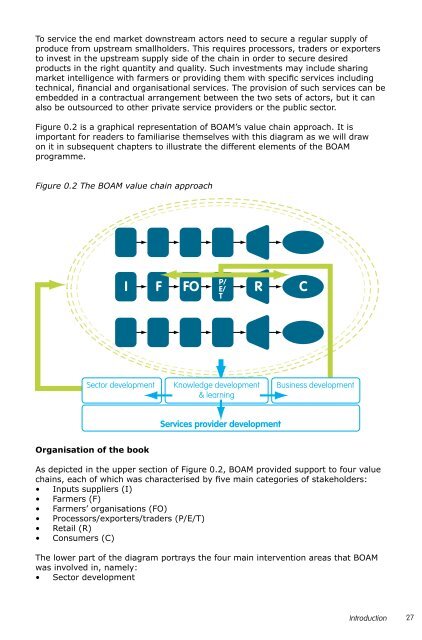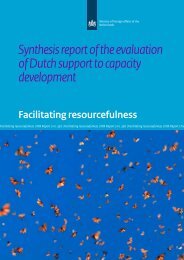Pro-Poor Value Chain Development - Capacity.org
Pro-Poor Value Chain Development - Capacity.org
Pro-Poor Value Chain Development - Capacity.org
You also want an ePaper? Increase the reach of your titles
YUMPU automatically turns print PDFs into web optimized ePapers that Google loves.
To service the end market downstream actors need to secure a regular supply of<br />
produce from upstream smallholders. This requires processors, traders or exporters<br />
to invest in the upstream supply side of the chain in order to secure desired<br />
products in the right quantity and quality. Such investments may include sharing<br />
market intelligence with farmers or providing them with specific services including<br />
technical, financial and <strong>org</strong>anisational services. The provision of such services can be<br />
embedded in a contractual arrangement between the two sets of actors, but it can<br />
also be outsourced to other private service providers or the public sector.<br />
Figure 0.2 is a graphical representation of BOAM’s value chain approach. It is<br />
important for readers to familiarise themselves with this diagram as we will draw<br />
on it in subsequent chapters to illustrate the different elements of the BOAM<br />
programme.<br />
Figure 0.2 The BOAM value chain approach<br />
P/<br />
I F FO E/ R C<br />
Sector development Knowledge development<br />
& learning<br />
Organisation of the book<br />
Services provider development<br />
Business development<br />
As depicted in the upper section of Figure 0.2, BOAM provided support to four value<br />
chains, each of which was characterised by five main categories of stakeholders:<br />
• Inputs suppliers (I)<br />
• Farmers (F)<br />
• Farmers’ <strong>org</strong>anisations (FO)<br />
• <strong>Pro</strong>cessors/exporters/traders (P/E/T)<br />
• Retail (R)<br />
• Consumers (C)<br />
The lower part of the diagram portrays the four main intervention areas that BOAM<br />
was involved in, namely:<br />
• Sector development<br />
T<br />
Introduction<br />
27













